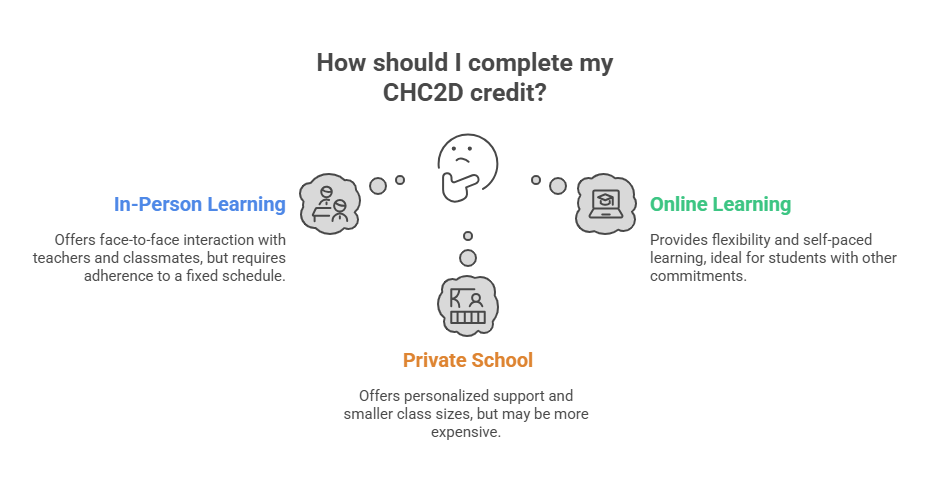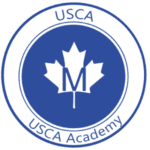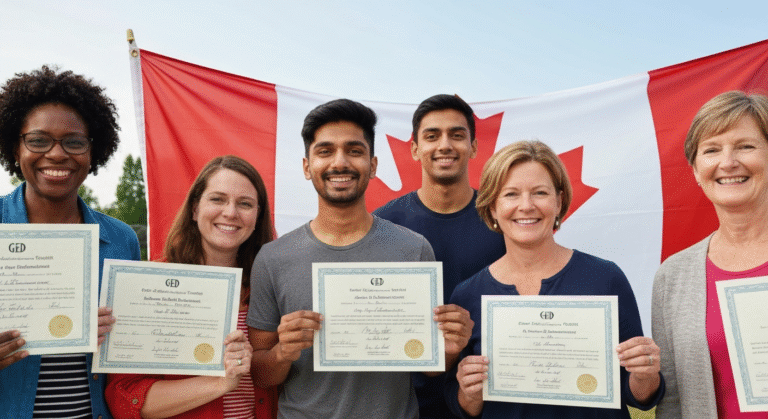Key Highlights of CHC2D Course
- The CHC2D course teaches about Canadian history from World War I in 1914 up to the present.
- This is a required Grade 10 course that every student takes in high school in Ontario.
- The curriculum helps you learn the inquiry process and teach you about concepts of historical thinking.
- You study the impact of various individuals and events and how these have led to Canada’s progress.
- The course puts a strong focus on how Canada’s national identity has changed and Canada’s place with others in the world.
- You will look into the impact of various individuals and events to see how they helped shape Canadian identity.
Introduction to the CHC2D Course
The CHC2D course is a key part of the Grade 10 Ontario curriculum. It lets you learn about Canadian history from 1914 up to now. This is a course you must take to graduate from high school. It is made for students who want to be on an academic path. In this class, you will get to look at the social, political, and economic events that help shape Canada as we know it today.
You will see how the country dealt with big conflicts and the role of conflict in how Canada’s identity has changed, as well as how it acts with other countries in the world. The CHC2D course is important for all students who want to know more about what makes Canada the place it is now.
Understanding the CHC2D Course Code
The “CHC2D” course code signifies a Grade 10 Canadian History course focusing on Canadian history since World War I at the Academic level. Each component of the code indicates the subject area, grade level, and stream.
What Does the CHC2D Course Code Mean?
The CHC2D course code gives you a simple way to understand the course that is set by the Ministry of Education. Every letter and number in this code has a clear reason. Each one links with the official curriculum expectations that the schools must follow. Schools give out course outlines and the course plan that explain these expectations for you.
Here is how it works:
- C: The first letter means “Canadian and World Studies.” This is the general subject.
- H: The second letter is “H,” which shows that this is about “History.”
- C: The third letter, “C,” is for “Canadian History Since World War I.” This tells you the course is about Canadian history after world war one.
At the end, the last two parts show the grade and the type of course. The “2” is for Grade 10. The “D” is for “Academic” level, which is planned to get you ready for studies at universities. The way this system is made keeps every Ontario school using the same steps so there is no mix up.
Difference Between CHC2D (Academic) and CHC2P (Applied)
When choosing your courses, it is vital to understand the difference between the academic (D) and applied (P) pathways. CHC2D is the academic stream, focusing on theoretical knowledge, abstract thinking, and in-depth analysis. It is designed for students who plan to pursue university after high school. In contrast, CHC2P is the applied stream, which emphasizes practical applications and connections to real-world situations, preparing students for college, apprenticeships, or the workplace.
Both courses cover similar historical content but approach it differently. The academic course involves more independent research and essay writing, while the applied course may feature more hands-on projects and guided activities. Schools provide accommodations for students with special education needs in both streams, often outlined in an Individual Education Plan (IEP), to ensure that at the beginning of the school year, everyone has a fair opportunity to succeed.
Here is a simple breakdown of the differences:
Feature | CHC2D (Academic) | CHC2P (Applied) |
|---|---|---|
Primary Focus | Theoretical concepts and abstract analysis | Practical applications and concrete examples |
Learning Style | Independent study, research, and theoretical discussion | Guided instruction and hands-on activities |
Pace and Depth | Faster-paced with a focus on in-depth analysis | More methodical with a focus on essential concepts |
Post-Secondary Pathway | Prepares students for university (U-level) courses | Prepares students for college (C-level) or workplace courses |
Course Structure and Delivery Options
The CHC2D course offers flexible delivery options tailored to your learning style, including in-person classes and online formats. USCA Academy provides personalized support and adaptable scheduling to meet your educational needs. You can choose to take the course during the school year or over the summer, ensuring a perfect fit for your schedule.
Grade Level and Prerequisites
- The CHC2D course is designed for Grade 10 students.
- It is offered during the regular school year.
- There are no prerequisite history courses required from Grade 9.
- Any Grade 10 student can enroll and learn about Canada’s modern history while building important skills.
- Students with special education needs will receive support according to their individual education plan to help them succeed in the course.
Ways to Take the Course: In-Person, Online, or Private School

You have a few ways to finish your CHC2D credit. The most common way is to take an in-person class at a public or Catholic high school during the school year. You get to meet the teachers and your classmates face-to-face. Still, this is not the only way to do it.
A lot of students, now, go for online learning. Schools like Ontario Virtual School or Christian Virtual School give you the freedom to work at your own pace and from anywhere. A private school could work, too. The classes there are smaller, and you may get one-on-one help from your teacher.
Some good things about online or private schools are:
- Flexible Scheduling: You learn at your own speed. This is great if you work, play sports, or do other things.
- Self-Paced Learning: You can finish the class in about four weeks, or you can take up to a year.
- Personalized Support: You may get smaller classes or get more time with your teacher.
- Location Independence: You can see course materials and send in assignments from anywhere, as long as you have the internet.
What Students Learn in CHC2D
In the Canadian History Since World War I Grade 10 course, students learn to think critically about historical events and their significance to Canadian society. They engage in the historical inquiry process, focusing on key concepts like perspective and causation to understand Canada’s development.
Major Historical Periods (1914–Present)
Yes, the CHC2D course teaches Canadian history from 1914 to today. The lessons are split into four main parts, and each one covers an important time when Canada changed.
First, you learn about the First World War and how life changed in the 1920s. This part shows how Canada started making more of its own decisions.
Next, you study the years from 1929 to 1945, which include the Great Depression and Canada’s role in the Second World War. After that, you learn about how Canada grew after the war, picked its own flag, and faced new problems between 1945 and 1982. The last part brings you to the present, looking at Canada’s role in the world and the challenges it deals with now.
Learning about these years in order helps you understand how one event leads to another. You get a clear picture of how Canada has changed over the last hundred years.
Key Skills and Competencies Developed
The main goal of CHC2D is to help you build strong and useful skills. The course is not just about learning history facts. It is made to help you get better at critical thinking and problem solving. You will learn to ask questions and look for answers using an inquiry process. When you read about the past, you will use proof to back up what you think.
You will spend time working on analysis of evidence. You will be taught how to spot the difference between primary and secondary sources. After that, you will think about how much you can trust each one.
You will also learn about concepts of historical thinking. This means knowing which events or people matter, seeing what led to things or what happened because of them, spotting what has stayed the same or changed, and thinking about how people in the past saw the world. These skills are needed not just in history, but in other subjects and at work.
By the time the course is done, you will be good at:
- Historical Inquiry: Looking into events, issues, and ideas using an inquiry process.
- Evidence Analysis: Looking over information from different history sources and using it the right way.
- Critical Thinking: Making strong points and smart choices by using proof.
- Communication: Sharing your ideas and thoughts well in writing and when you talk.
Examples of Assignments and Projects
The assignments in CHC2D help you take part in the course and show what you know. Instead of just doing tests, you will do different tasks that ask you to do analysis of evidence and practice historical inquiry. The teachers use these as part of assessment and to give you ongoing descriptive feedback. This helps you get better at your skills as you move through the course.
You might have to take part in an online discussion, make a graphic organizer that shows how historical events are linked, or research a certain topic in Canadian history. For example, you might look at a political cartoon from the 1930s, write an essay about how Canada’s identity has changed, or make a presentation that talks about what one important person did.
Common assignments include:
- Research Projects: For example, looking into a main event like the Battle of Vimy Ridge, or a person such as Lester B. Pearson in Canadian history.
- Source Analysis: For example, studying old letters from soldiers in World War I, photos from the Great Depression, or government papers about residential schools.
- Essays and Reports: For example, making an argument about how Canada changed after World War II and backing it up with proof from historical sources.
- Presentations: For example, showing your research and what you found to the class through a slideshow about women’s roles in Canadian history.
Evaluation and Grading in CHC2D
Evaluation in the CHC2D course focuses on improving student learning throughout the year, using various assessment methods. Your final grade reflects your overall performance, including classwork and a final exam or major project, emphasizing consistent effort and growth. Descriptive feedback helps you understand your strengths and areas for improvement.
Coursework, Final Exam, and Tips for Success
Your final grade for CHC2D is made in a simple way. Seventy percent comes from assessment during the year. The rest, which is thirty percent, is from the final exam or a big project at the end.
Your work is looked at in four main parts: Knowledge and Understanding, Thinking/Inquiry, Communication, and Application. This helps your teacher to check all of your skills. To do well, be sure to keep up with the material and use the descriptive feedback your teacher gives you. Good problem solving and critical thinking will help you a lot.
Here are some tips for doing well in CHC2D:
- Stay Organized: Keep your deadlines in mind and sort your notes for every unit.
- Participate Actively: Talk in the class and join in. This will help you learn more.
- Ask Questions: If you do not get something, just ask your teacher to help you.
- Review Feedback: Read all of the teacher’s comments on your work and use them to make your work better.
Conclusion
To sum up, the CHC2D course is a key way to learn about Canadian history. The course has a clear and fun structure. Students get to look at important times and events from 1914 to now. In this class, they build strong critical thinking and research skills. These skills help a lot in their school journey.
The learning can be done online, in-person, or at a private school. This flexibility lets students choose what works best for them. Taking this course helps people see the value in knowing Canada’s past. It is good for those who want to keep learning more later. If you want to know more about how to join, or you have any other questions, feel free to get in touch.
Frequently Asked Questions
1. Can international students enroll in CHC2D?
Yes, international students can take the CHC2D Canadian History Grade 10 course through USCA Academy. They can do this online. It’s a good way for them to get a credit for the Ontario Curriculum. This is helpful for their high school diploma (OSSD), even if they live in other countries.
2. How long does it usually take to complete CHC2D online?
The time it takes to finish an online CHC2D course can be different for each person. You might finish it in just four weeks. Some people use the whole school year. This flexible learning environment helps you complete your Grade 10 Canadian History credit at your own pace.
3. Does CHC2D help with university or college admissions later?
Yes, CHC2D is a key class in Grade 10 for the Ontario curriculum. You must finish this course to get your high school diploma. If you do well, it shows you have strong thinking skills. These skills are important to help you get into university or college programs.
4. Are there summer school options for CHC2D?
Yes, many school boards and private school providers, including USCA Academy, give students the chance to take CHC2D in summer school. This is a good way for people to get their Canadian History credit in less time and outside of the regular school year. It lets you open up your schedule for some other courses.









